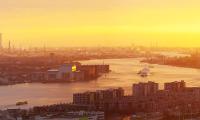
North Sea Wind Power Hub Programme and Port of Rotterdam: towards a long-term view
The upcoming stages of the NSWPH Programme require constant flexibility: not just by responding quickly to recent political developments and the latest insights in the field, but also by closely reviewing the roles of all the partners involved. During the latter process, the Port of Rotterdam recently suggested to take up a new role in the Programme. ‘Up until this summer, the NSWPH was in its broad assessment phase’, says Wilco van der Lans, Business Manager at Port of Rotterdam. ‘All of the partners worked together to get a clear view of the challenges and possibilities. It was mainly a period of doing studies and research. It was very inspiring to experience this first phase from within.’
An enormous scope
The assessment phase revealed the enormous scope of the project. By getting a better perspective on the entire process, it also became clear that the Port of Rotterdam wouldn’t be able to play the role it had initially in mind – at least not in the near future.
‘We aimed at realising and overseeing the hubs as islands, on which the installations would be built’, says Wilco. ‘The hubs would have port-like facilities, an idea perfectly suited to one of our specialties: developing a smoothly working port infrastructure on new land reclaimed from the sea, like the Maasvlakte 2-project, which was successfully delivered in 2013.’
The port’s added value
However, the chance that the hubs actually would come to look like big islands, and would be realised and built within the next few years, turned out to be smaller than the Port of Rotterdam had expected. During the assessment phase the issue of onshore landing and integrating wind power became more and more important, as well as the role ports and industrial areas could play in integrating wind power. Wind power proved to be fundamental in helping industrial activities to become CO2-emission free.
The role in the future
So the Port of Rotterdam area still has a crucial role to play. ‘Put simply’, Wilco explains, ‘all that wind has to be caught at sea. But on land too, space has to be created to convert and stabilise all that energy. Industry could absorb a lot of this renewable energy and could also convert wind power to other energy carriers, like hydrogen. There are fluctuations, peaks and troughs, and we have to be able to deal with that. Should the energy from NSWPH’s network fall short, you have to have a reserve, an alternative renewable energy source, like imported renewable hydrogen or biomass. We could provide such a reserve. That would be our role in the future. The way in which we could make a difference, and put our knowledge and experience to its best use.’
